ISS: CALET (Calorimetric Electron Telescope)
Astronomy and Telescopes
ISS Utilization: CALET (Calorimetric Electron Telescope)
CALET is an astrophysics mission of JAXA (Japan Aerospace Exploration Agency) and Japanese Universities that will search for signatures of dark matter and provide the highest energy direct measurements of the cosmic ray electron spectrum. CALET is to be installed on the JEM-EF (Exposed Facility) for long-term observations. The objectives are to study the following: 1) 2)
1) The origin and the mechanisms of acceleration of high-energy cosmic rays and gamma rays
2) The propagation mechanism of cosmic rays throughout the galaxy
3) The search for signatures of dark matter has become a focus of particle astrophysics since dark matter is hypothesized to be one of the major constituents of the universe.
As a cosmic ray observatory, CALET aims to clarify high energy space phenomena and dark matter. from two perspectives; one is particle creation and annihilation in the field of particle physics (or nuclear physics) and the other is particle acceleration and propagation in the field of space physics.
Investigators will measure these particles using a high-resolution telescope. The investigation addresses many unresolved high-energy astrophysics questions that have puzzled scientists for decades, such as the origin of cosmic rays, how cosmic rays accelerate and travel across the galaxy, and whether dark matter and nearby cosmic ray sources exist. The investigation also may help characterize the radiation environment and the risks it may pose to humans in space. Additionally, CALET's long exposure in space may yield evidence of rare interactions between “normal” matter and dark matter.
Cooperation agreements: 3)
JAXA and ASI (Italian Space Agency) made an arrangement in 2011 for the cooperation on CALET mission. According to the agreement, JAXA will provide, beside the main development of the mission, scientific data of CALET to ASI. In reverse, ASI will provide to JAXA the HVPS (High Voltage Power Supply) units for CGBM (CALET Gamma-Ray Burst Monitor) and CAL on board CALET along with scientific and technical supports by Italian researchers belonging to Italian Institutes led by CNR-IFAC and the University of Siena. These researchers have experience on a similar space observation mission. This collaboration will mitigate the risk of new hardware development and maximize the worldwide scientific achievement. 4)
CALET is a joint research project of JAXA and Waseda University led by Professor Shoji Torii (Faculty of Science and Engineering, Waseda University). Among the Japanese team, 22 research institutes such as Kanagawa University, Aoyama Gakuin University, and the Institute for Comic Ray Research, University of Tokyo, are also participating in this project.
In addition, NASA and American researchers provided the project with technical support for the cosmic rays observation sensor technology, while ASI and Italian researchers assisted with high-voltage power and cosmic rays observation sensor technology. Both of them will mutually cooperate in analyzing CALET observation data.
CALET Instrument
The CALET "pallet" for the mission, illustrated in Figure 1, contains a star tracker (ASC) a gamma-ray burst monitor (GBM: SGM and HXM), the mission data controller (MDC) and the main telescope (CAL). The star tracker will provide fine pointing knowledge for observed sources or for events seen by the GRB monitor. This mission equipment fills the standard pallet which has been successfully tested in an HTV launch as well as being in use for current experiments on the JEM-EF. CALET will employ the ISS cooling loop and the heat exchange piping. 5)
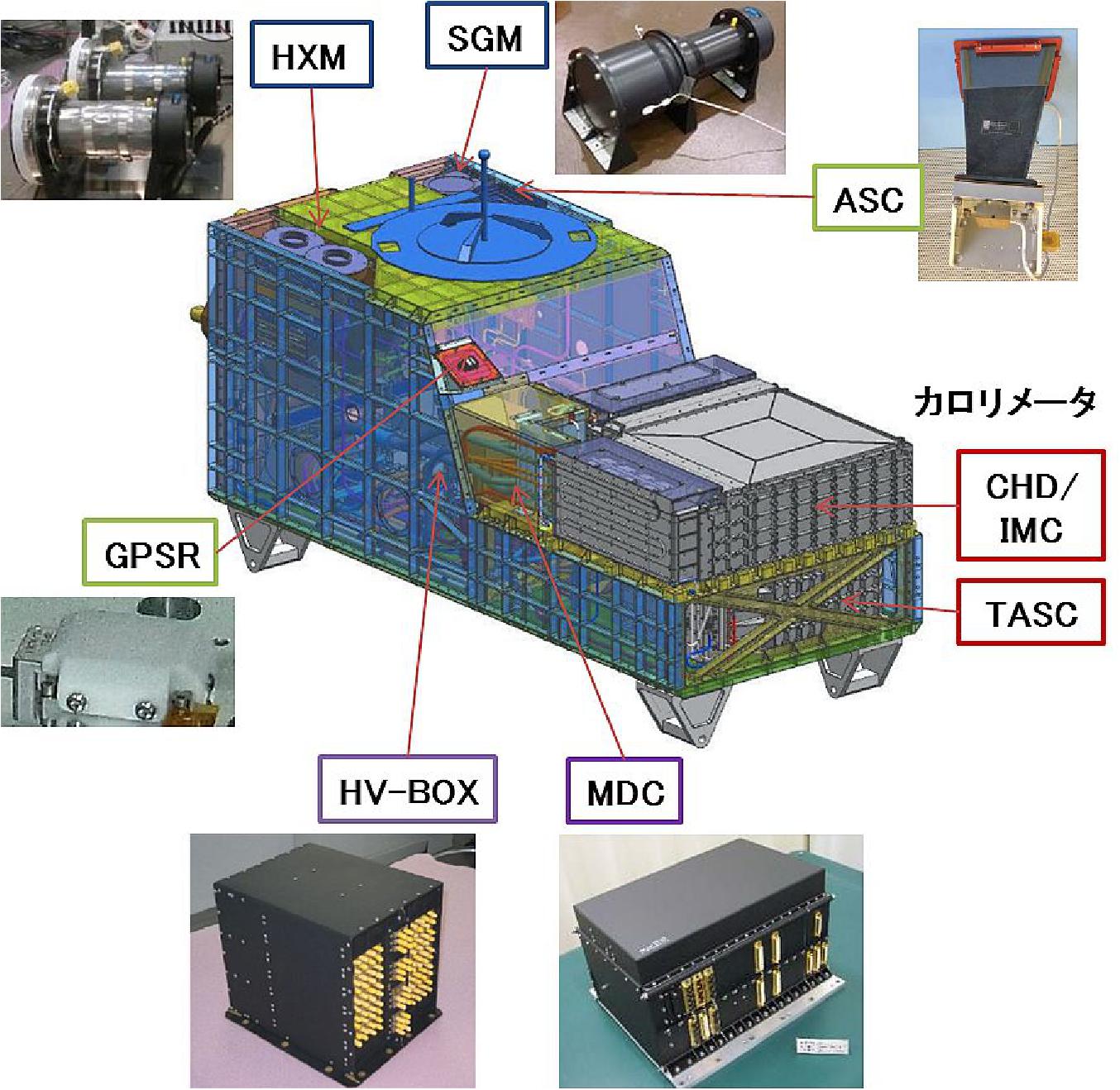
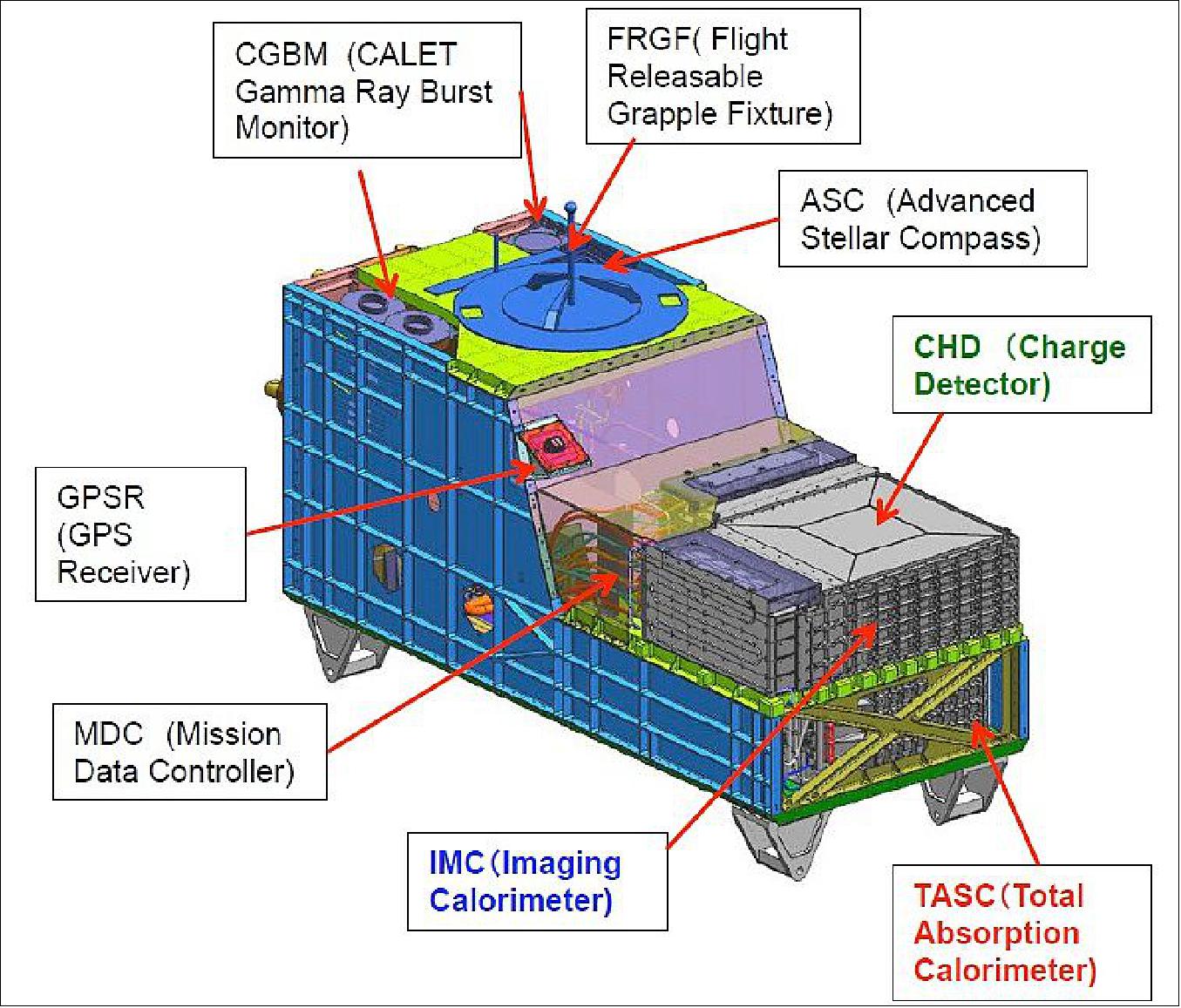
CALET is capable of making direct measurements at the highest energy levels in the cosmic ray electron spectrum for the observation of discrete sources of high energy particle acceleration in our local region within the Milky Way. The telescope payload has a mass of 650 kg and looks forward to a two to five-year stay attached to the JEM-EF (Japanese Experiment Module Exposed Facility), Port #9, looking in the zenith direction (Figure 7).
CALET consists of a detector system and data processing units, support sensors and an interface unit that attaches the payload to the Exposed Facility. The detector system is comprised of a CHD ( Charge Detector), an IMC (Imaging Calorimeter), a TASC (Total Absorption Calorimeter) and the CGBM (CALET Gamma-Ray Burst Monitor). The support sensors include a GPS receiver and an ASC (Advanced Stellar Compass) for precise position and orientation determination.
The CALET instrument interfaces with the JEM-EF via a standard FRAM (Flight Releasable Attachment Mechanism) which includes power and data interfaces with the Station's systems. CALET requires a peak power of 650 W and operates at data rates of 35 kbit/s in low data mode and 600 kbit/s in high data mode. The payload has a size of 1.85 x 0.8 x 1.0 m , complying with the envelope available for external JEM-EF payloads.
The CHD system consists of two layers each consisting of 14 organic scintillator paddles provided by ELJEN Technology. Each of the paddles measures 45 x 3.2 x 1 cm with the different layers arranged orthogonally. The organic scintillator material absorbs the energy of incident ionizing radiation and re-emits the absorbed energy in the form of light that can be measured in a detector. CALET uses PMTs (Photomultiplier Tubes) with 8 mm photocathodes to detect the emission of radiation from each scintillator paddle. Through data processing, the charge of each incident particle can be measured in a range from Z=1 to Z=40.
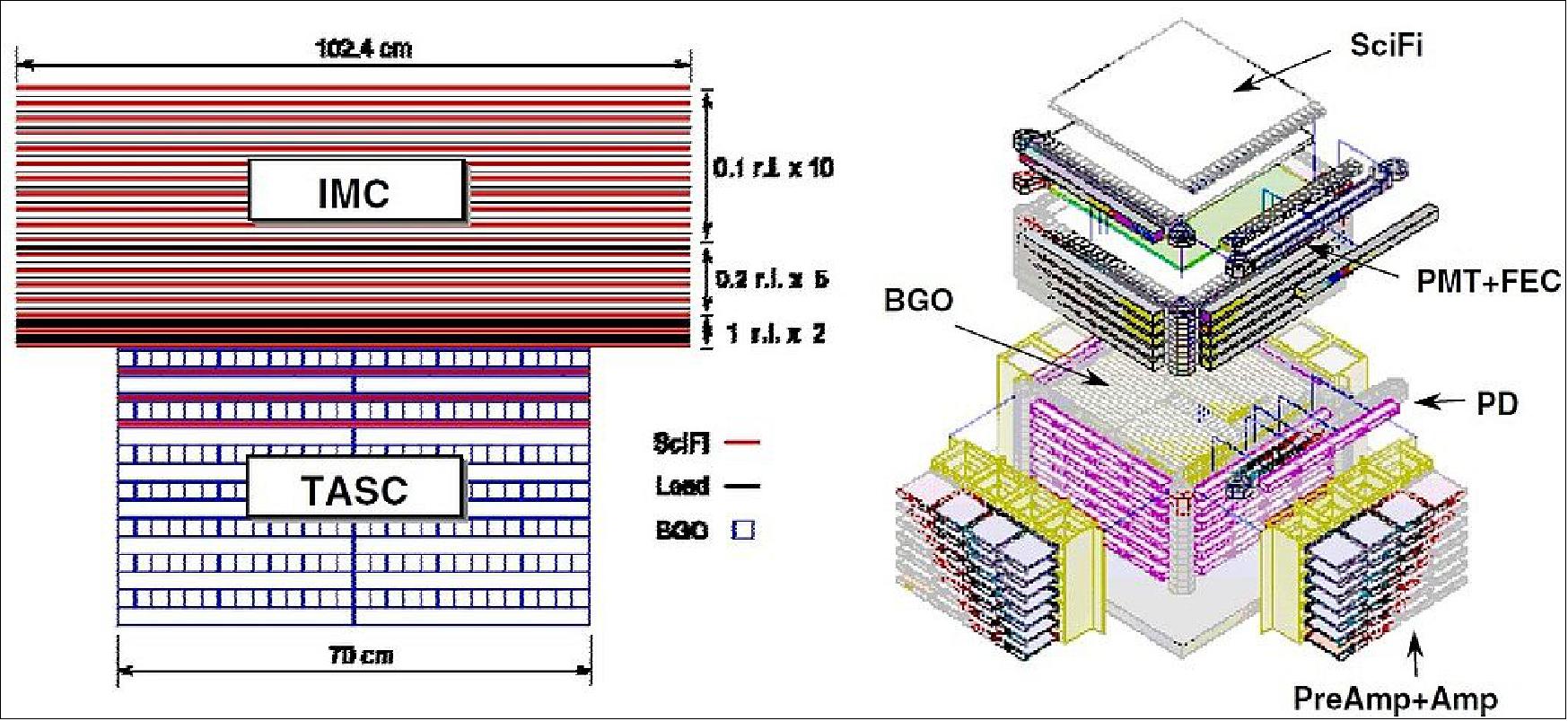
Imaging Calorimeters are characterized by a finely granulated readout with a high degree of segmentation featuring a large number of readout channels as opposed to conventional calorimeters consisting of large crystals connected to a single read-out channel. This allows for a detailed measurement of particle identity, travel direction and energy as well as the creation of particle flow algorithms. Imaging Calorimeters have a sandwiched design, alternating between active detector elements and passive absorber elements.
The CALET Imaging Calorimeter makes use of seven tungsten plates as absorbers and 16 layers of 448 scintillating fibers, one stack of eight layers in the x-plane, the other in the y-plane to enable directional measurements.
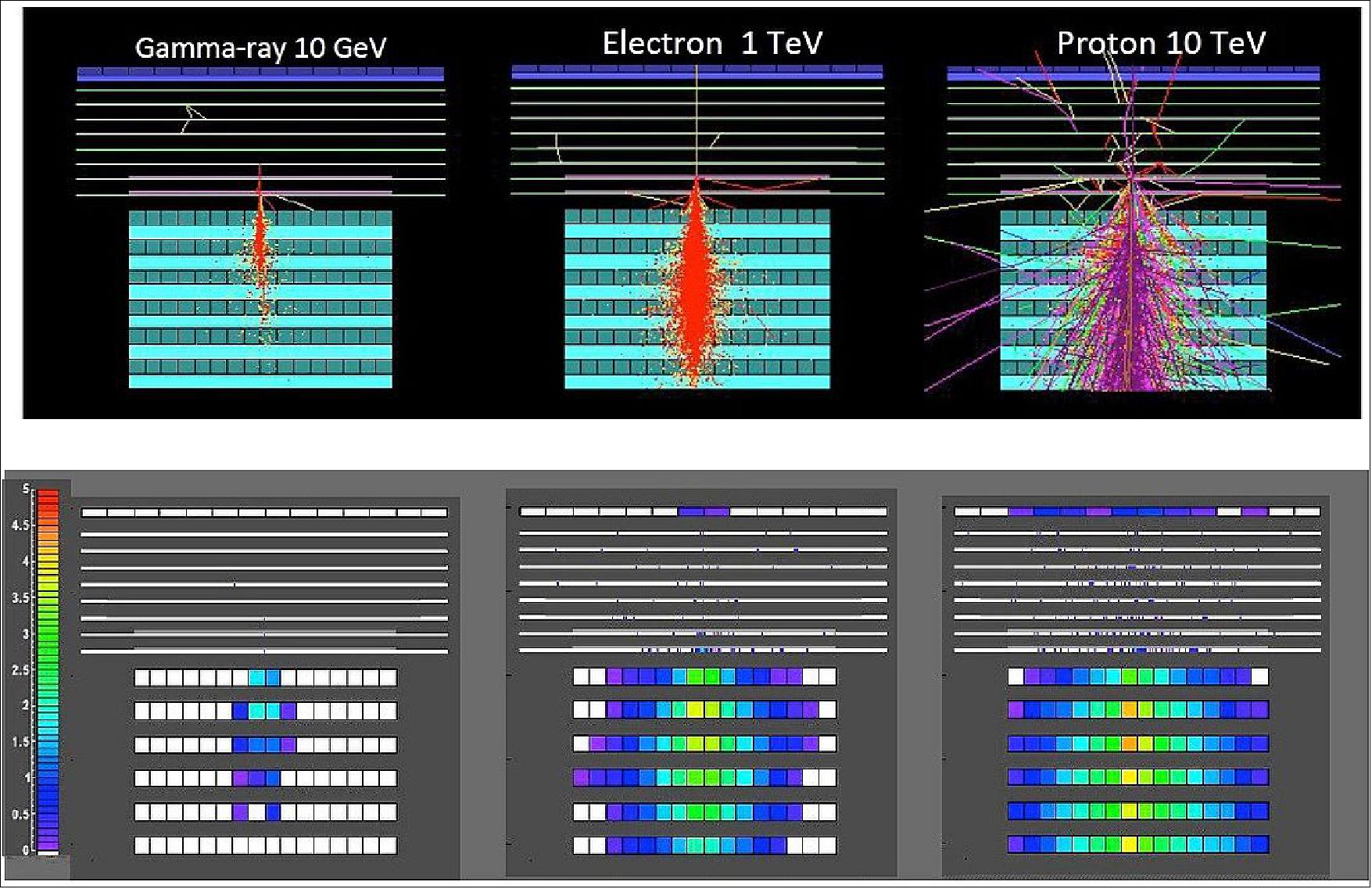
Each of the fibers measures 44.8 x 0.1 x 0.1 cm. Emissions from the fibers are read out by a suite of multi-anode (64) photomultipliers coupled to Readout Electronics based on application-specific integrated circuits that digitize the signals from each fiber with precise time-stamps for event logging. The arrangement of active elements within the system has been chosen to provide the precision necessary to separate incident particles from backscattered particles, precisely determine the starting point of the shower and determine the incident particle trajectory. The primary purpose of the CALET Imaging Calorimeter is the measurement of particle direction while the energy measurement is accomplished with the Total Absorption Calorimeter.
Located atop the Imaging Calorimeter is a silicon detector array consisting of two layers with 6,400 pixels, each square in shape with a side length of 1.125 cm and a thickness of 500 µm. The silicon detector array delivers the necessary charge resolution for the measurement of light and heavy nuclei.
The Total Absorption Calorimeter consists of 12 layers each comprised of 16 lead-tungstate logs that act as absorbing material, each measuring 32.6 x 1.9 x 2.0 cm. Subsequent layers are arranged orthogonally. Events are triggered by a PMT that is located atop the uppermost layer to send a start pulse. The remaining layers feature avalanche photodiodes for the measurement of the depth of penetration of any given particle to assess its energy. The Total Absorption Calorimeter has a field of view of 45º around the zenith. It separates electrons and gamma rays from incident hadrons.
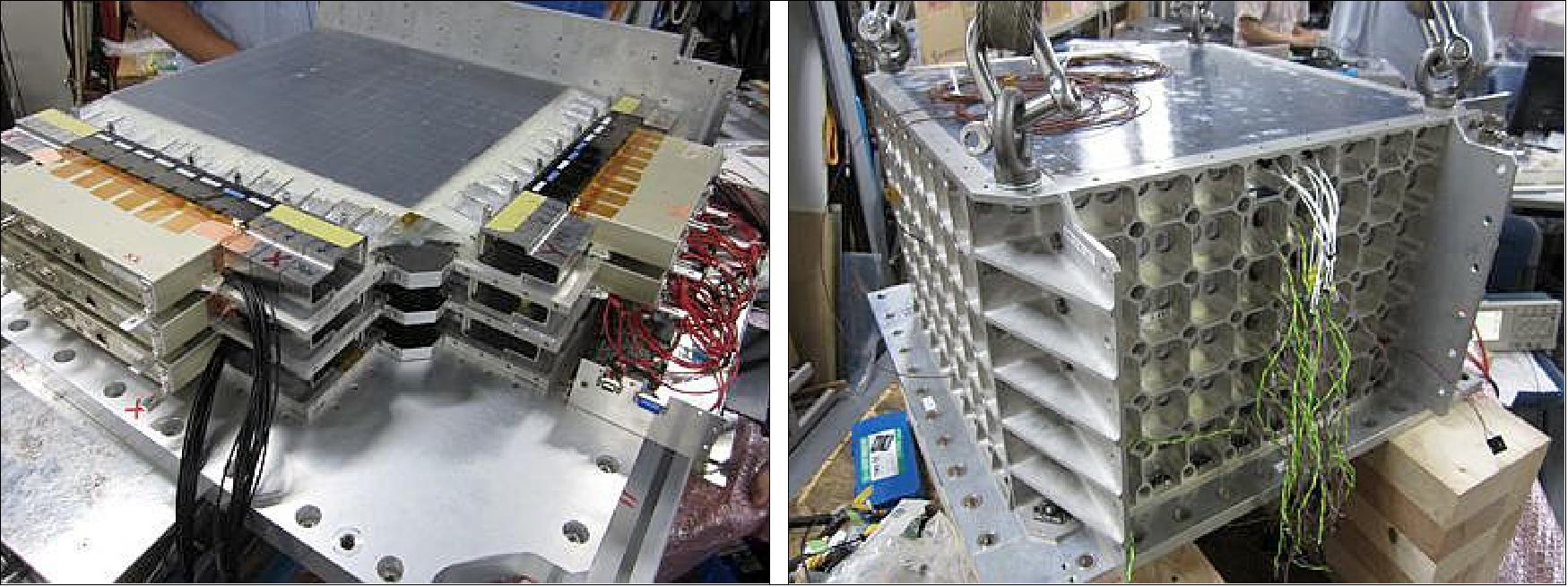
A separate CGBM (CALET Gamma-ray Burst Monitor) can detect particle events from a few keV X-rays to gamma-rays in the TeV range with durations varying from short duration gamma ray bursts, x-ray flashes to longer burst events. It has a time resolution of 62.5 ms and an energy range of 3% at 10 GeV. Two components make up the CGBM, the SGM (Soft Gamma-ray Monitor) and the HXM (Hard X-ray Monitor). SGM uses a single Bismuth Germanate scintillator of size 102 x 76 mm, covering an energy range of 100 to 20,000 keV. The HXM features a dual detector element using Lanthanum Bromide scintillators 12.7 mm thick and 66 x 79 cm in diameter. It covers an energy range of 7 to 1,000 keV. A Beryllium entrance window is used for the measurement of soft X-rays below 10 keV.

The non-detecting area of the entire CALET detector system is surrounded by a segmented scintillator array to serve as an Anti-Coincidence Detector, being triggered by all particles arriving from a direction that does not strike a detector from above, instructing the instrument to reject that measurement.
The thickness of the calorimeter sensors allows measurements well into the TeV (Tera Electron Volt) energy region with excellent energy resolution. The coupling of an imaging and total absorption calorimeter permits an accurate identification of the starting point of electromagnetic showers as well as the lateral and longitudinal development of showers.
CALET will deliver electron spectra in the trans-TeV region to look for nearby cosmic-ray sources, it will track dark matter annihilation electron/positron signatures in electron/gamma energy spectra at energies of 10 GeV to 10 TeV, it will provide spectral data sets starting with protons to heavier elements up to iron at 20 TeV/n plus heavier elements (Z=26-40) at a few GeV/n. CALET will also measure the electron flux at energies below 10 GeV to support solar physics and record Gamma-ray and X-ray events in the low-energy range from 3 keV to 30 MeV. Gamma-ray measurements for an indirect measurement of dark matter decay will also be supported by CALET.
CALET delivers its data flow to the ISS Data System where science data is stored or downlinked in realtime depending on TDRSS availability. Downlinked data is relayed to the MSFC (Marshall Spaceflight Center) from where raw data is transmitted to Tsukuba Space Center, going through the JAXA Operations Control System to reach the CALET Ground System. Raw data is directed to an archiving system and to the various processing locations where higher science products from Level 1 quick look data to Level 3 calibrated calorimeter and Gamma-ray Burst Monitor data is created, archived and made available via a web server.

Launch
The CALET instrumentation was launched on the HTV-5 vehicle (nicknamed Kounotori 5) of JAXA on August 19, 2015 at 11:50:49 UTC from the Tanegashima Launch Center, Japan. The launch vehicle was H-IIB of MHI (Mitsubishi Heavy Industries, Ltd.) and CALET was part of the payload of HTV-5. The launch vehicle flew smoothly, and, at about 14 minutes and 54 seconds after liftoff, the separation of the Kounotori-5 was confirmed. 6)
Orbit: Near-circular orbit, altitude of ~400 km to ISS, inclination =51.6°.
Mission Status
• April 27, 2023: The International Space Station (ISS) partners have agreed to extend the operational period of the ISS. The United States, Japan, Canada and participant European Space Agency (ESA) countries will support operations until 2030, while Russia has committed to continuing station operations until 2028. 27)
• June 18, 2021: New findings published this week in Physical Review Letters suggest that carbon, oxygen, and hydrogen cosmic rays travel through the galaxy toward Earth in a similar way, but, surprisingly, that iron arrives at Earth differently. Learning more about how cosmic rays move through the galaxy helps address a fundamental, lingering question in astrophysics: How is matter generated and distributed across the universe? 7)
- "So what does this finding mean?" asks John Koranic, a senior scientist with UMBC Center for Space Science and Technology (CSST). "These are indicators of something interesting happening. And what that something interesting is we're going to have to see."
- Cosmic rays are atomic nuclei—atoms stripped of their electrons—that are constantly whizzing through space at nearly the speed of light. They enter Earth's atmosphere at extremely high energies. Information about these cosmic rays can give scientists clues about where they came from in the galaxy and what kind of event generated them.
- An instrument on the International Space Station (ISS) called CALET (Calorimetric Electron Telescope) has been collecting data about cosmic rays since 2015. The data include details such as how many and what kinds of atoms are arriving, and how much energy they're arriving with. The American, Italian, and Japanese teams that manage CALET, including UMBC's Krizmanic and postdoc Nick Cannady, collaborated on the new research.
Iron on the Move
- Cosmic rays arrive at Earth from elsewhere in the galaxy at a huge range of energies--anywhere from 1 billion volts to 100 billion billion volts. The CALET instrument is one of extremely few in space that is able to deliver fine detail about the cosmic rays it detects. A graph called a cosmic ray spectrum shows how many cosmic rays are arriving at the detector at each energy level. The spectra for carbon, oxygen, and hydrogen cosmic rays are very similar, but the key finding from the new paper is that the spectrum for iron is significantly different.
- There are several possibilities to explain the differences between iron and the three lighter elements. The cosmic rays could accelerate and travel through the galaxy differently, although scientists generally believe they understand the latter, Krizmanic says.
- "Something that needs to be emphasized is that the way the elements get from the sources to us is different, but it may be that the sources are different as well," adds Michael Cherry, physics professor emeritus at Louisiana State University (LSU) and a co-author on the new paper. Scientists generally believe that cosmic rays originate from exploding stars (supernovae), but neutron stars or very massive stars could be other potential sources.
Next-Level Precision
- An instrument like CALET is important for answering questions about how cosmic rays accelerate and travel, and where they come from. Instruments on the ground or balloons flown high in Earth's atmosphere were the main source of cosmic ray data in the past. But by the time cosmic rays reach those instruments, they have already interacted with Earth's atmosphere and broken down into secondary particles. With Earth-based instruments, it is nearly impossible to identify precisely how many primary cosmic rays and which elements are arriving, plus their energies. But CALET, being on the ISS above the atmosphere, can measure the particles directly and distinguish individual elements precisely.
- Iron is a particularly useful element to analyze, explains Cannady, a postdoc with CSST and a former Ph.D. student with Cherry at LSU. On their way to Earth, cosmic rays can break down into secondary particles, and it can be hard to distinguish between original particles ejected from a source (like a supernova) and secondary particles. That complicates deductions about where the particles originally came from.
- "As things interact on their way to us, then you'll get essentially conversions from one element to another," Cannady says. "Iron is unique, in that being one of the heaviest things that can be synthesized in regular stellar evolution, we're pretty certain that it is pretty much all primary cosmic rays. It's the only pure primary cosmic ray, where with others you'll have some secondary components feeding into that as well."
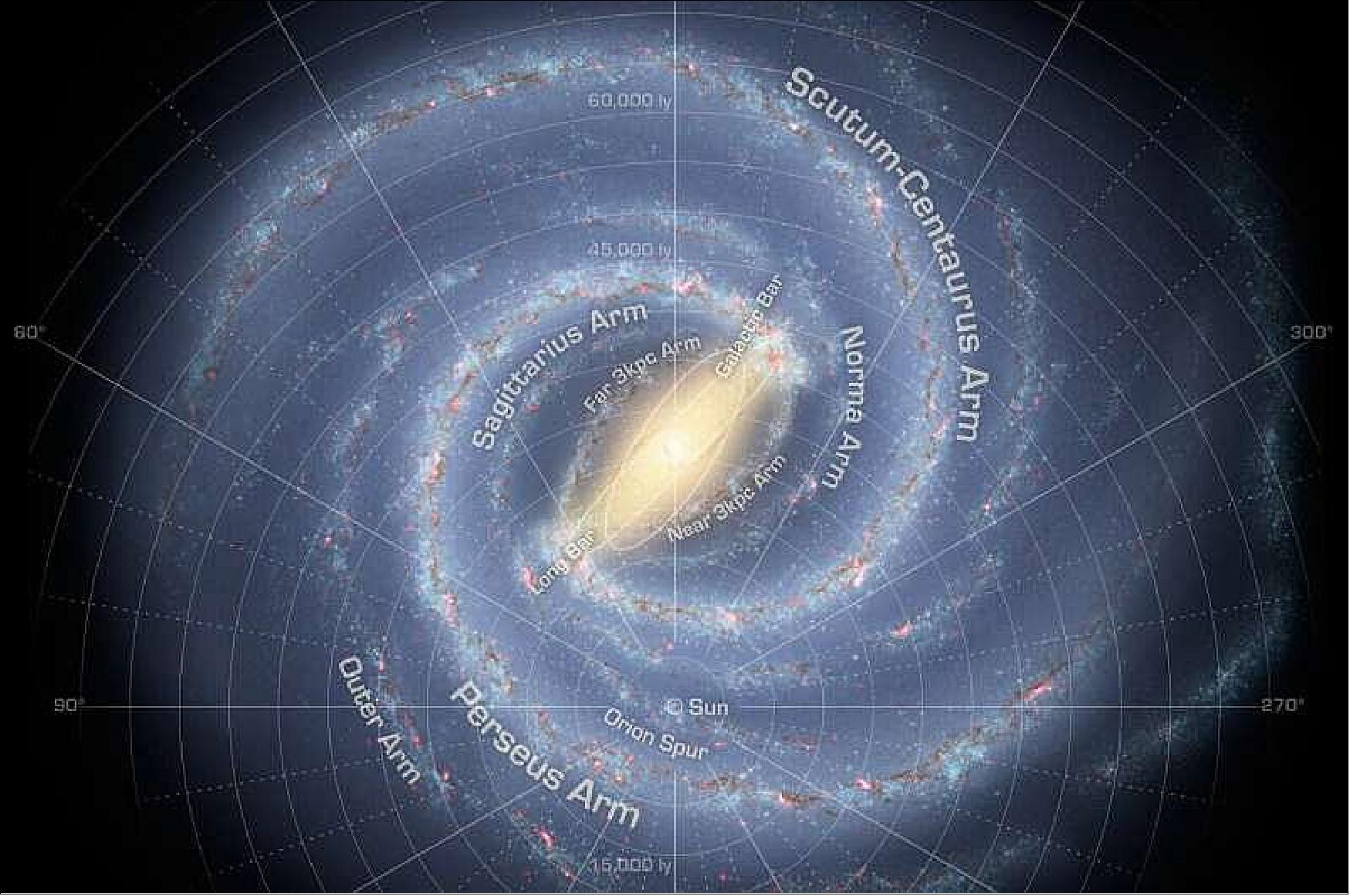
Made of Stardust
- Measuring cosmic rays gives scientists a unique view into high-energy processes happening far, far away. The cosmic rays arriving at CALET represent "the stuff we're made of. We are made of stardust," Cherry says. "And energetic sources, things like supernovas, eject that material from their interiors, out into the galaxy, where it's distributed, forms new planets, solar systems, and... us."
- "The study of cosmic rays is the study of how the universe generates and distributes matter, and how that affects the evolution of the galaxy," Krizmanic adds. "So really it's studying the astrophysics of this engine we call the Milky Way that's throwing all these elements around."
A Global Effort
- The Japanese space agency launched CALET and today leads the mission in collaboration with the U.S. and Italian teams. In the U.S., the CALET team includes researchers from LSU; NASA Goddard Space Flight Center; UMBC; University of Maryland, College Park; University of Denver; and Washington University. The new paper is the fifth from this highly successful international collaboration published in PRL, one of the most prestigious physics journals. 8)
- CALET was optimized to detect cosmic ray electrons, because their spectrum can contain information about their sources. That's especially true for sources that are relatively close to Earth in galactic terms: within less than one-thirtieth the distance across the Milky Way. But CALET also detects the atomic nuclei of cosmic rays very precisely. Now those nuclei are offering important insights about the sources of cosmic rays and how they got to Earth.
- "We didn't expect that the nuclei - the carbon, oxygen, protons, iron - would really start showing some of these detailed differences that are clearly pointing at things we don't know," Cherry says.
- The latest finding creates more questions than it answers, emphasizing that there is still more to learn about how matter is generated and moves around the galaxy. "That's a fundamental question: How do you make matter?" Krizmanic says. But, he adds, "That's the whole point of why we went in this business, to try to understand more about how the universe works."
• July 16, 2018: In search of dark matter signal: An international team of researchers succeeded in extending their result from a previous study and directly measured the cosmic-ray all-electron (electron + positron) spectrum in an energy range from 11 GeV to 4.8 TeV with the Calorimetric Electron Telescope (CALET). 9)
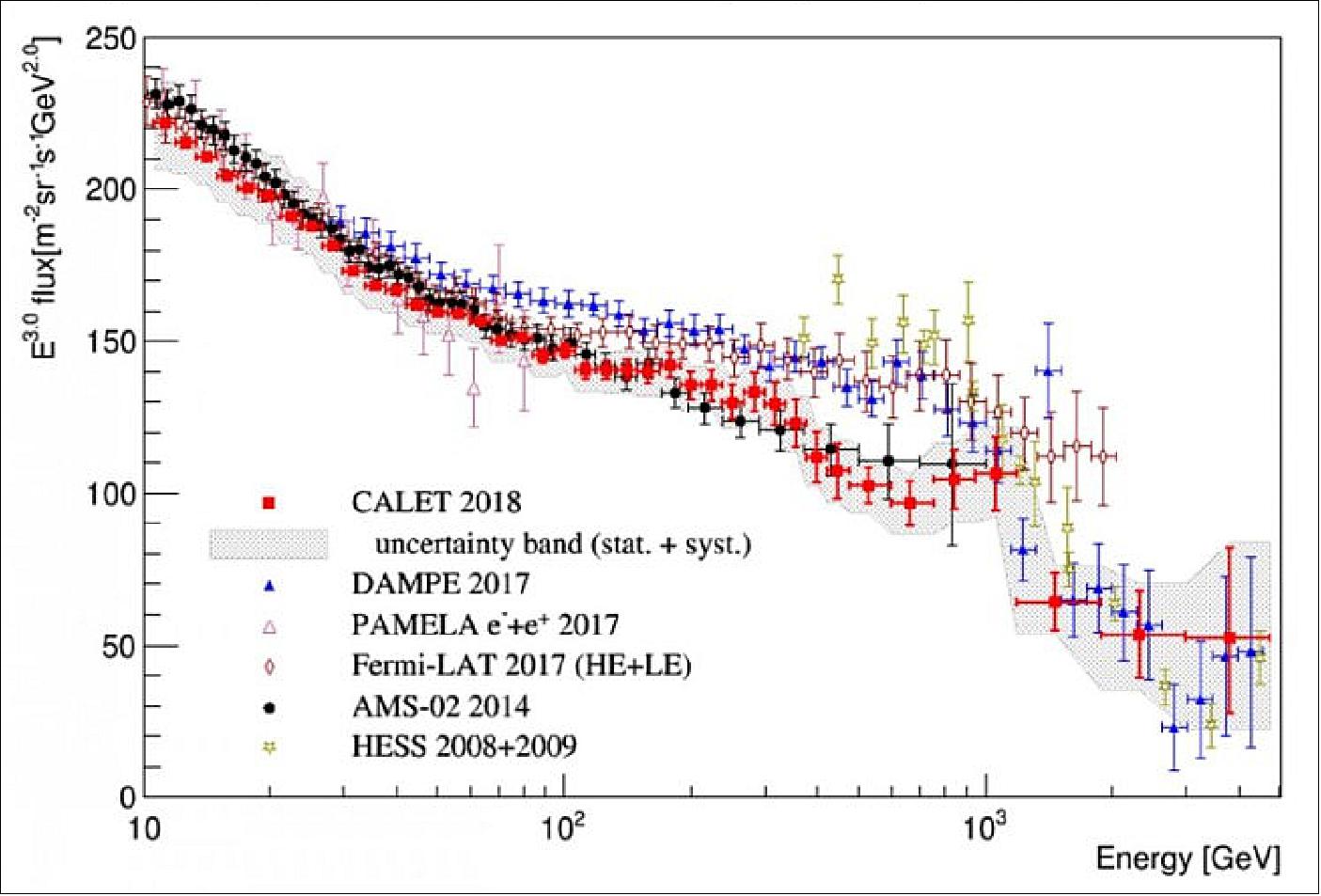
- CALET, a detector optimized to observe high-energy electrons, was installed on the Japanese Experimental Module Kibo on the International Space Station (ISS) on August 2015 as the first, Japanese-led, spaceborne mission dedicated to cosmic ray observations. Intended for a long-term operation, CALET has been accumulating data since October 2015.
- “I have been told that the international scientific community is interested in the observations by CALET because one of our objectives is to understand the origin of high-energy cosmic rays and the nature of dark matter, some of the most profound mysteries in this universe,” says Professor Shoji Torii of Waseda University, the principal investigator of the CALET mission.
- The origin and acceleration of cosmic rays are not yet well known, and cosmic-ray electrons are one of the priority targets of high-energy cosmic ray research. Precise measurements of electrons above 1 TeV have been difficult to achieve because they require high-precision energy measurements of the cosmic-ray particles, sensitivity to detect the rare electron flux, and capability of accurate electron identification from the more than 1,000 times higher flux of protons in the TeV energy region.
- "The long-term observations on the ISS and the calorimeter of CALET's capabilities, such as being able to identify the charge of incident particles, detect incident direction, and measure the particle energy and identify the species by detecting the particle shower development, have enabled our team to perform accurate measurements of cosmic-ray electrons into the TeV region," Professor Torii explains. Previously in November 2017, the team reported their first result in measuring the cosmic-ray electrons in the energy range from 10 GeV to 3 TeV in Physical Review Letters.
- In this recent study, they developed a new data analysis method to maximize detection at higher energies, approximately doubling the statistics compared to their previous study and allowing CALET to obtain high-precision measurements of cosmic-ray electron spectrum up to 4.8 TeV. 10)
- Professor Torii says that the statistics will improve nearly three times more than now by using data after a five-year observation. "It will also reduce systematic uncertainties, including that from the detector response. Our ultimate goal is to push the energy limit up to 20 TeV and obtain the precise energy spectrum, in which there is a high probability of discovering nearby astrophysical cosmic-ray resources or revealing the nature of dark matter."
• November 10, 2017: CALET, a space mission led by the JAXA (Japan Aerospace Exploration Agency) with participation from the Italian Space Agency (ASI) and NASA, has released its first results concerning the nature of high-energy cosmic rays. 11)
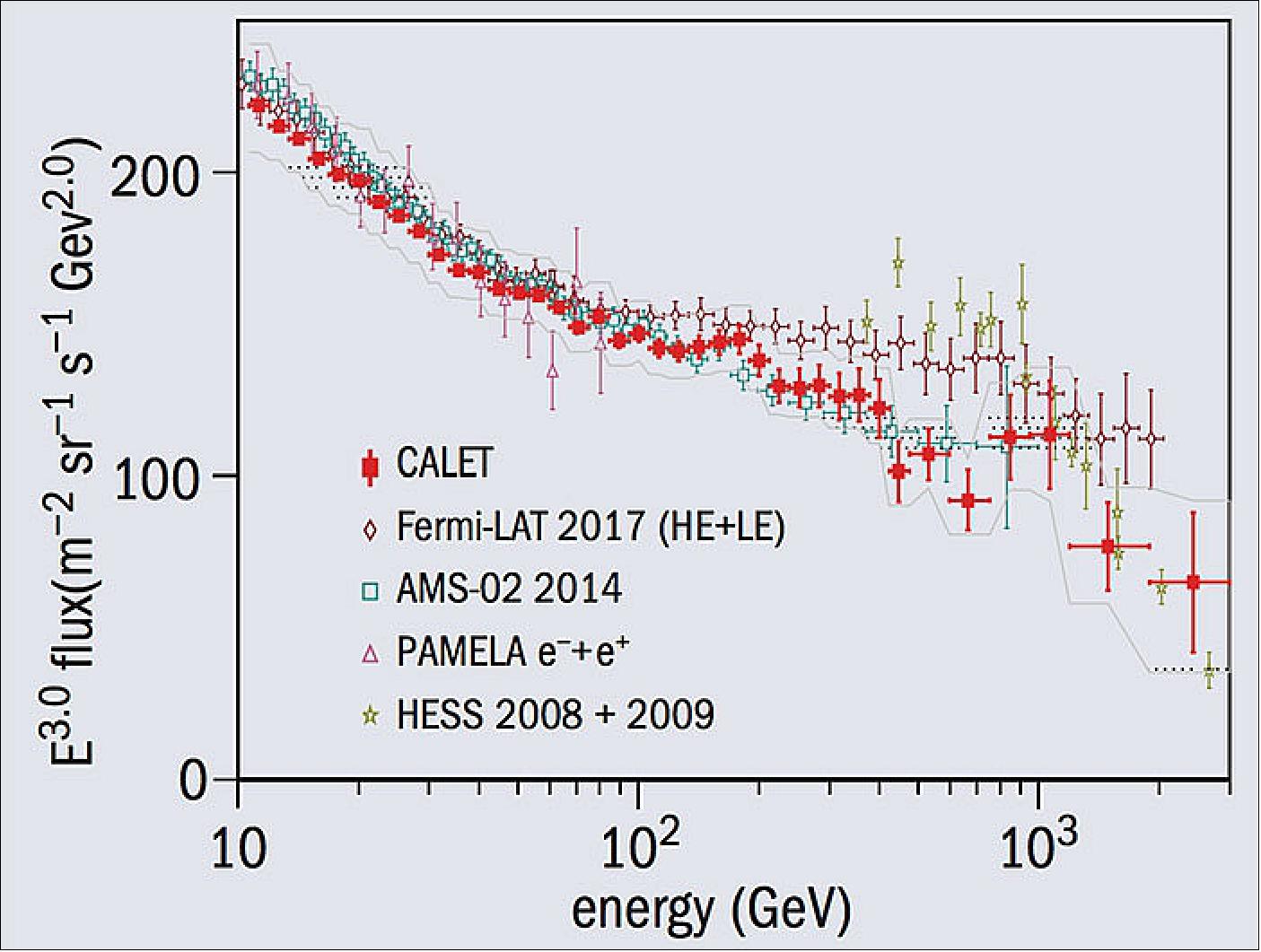
- Having docked with the ISS on 25 August 2015, CALET is carrying out a full science program with long-duration observations of high-energy charged particles and photons coming from space. It is the second high-energy experiment operating on the ISS following the deployment of AMS-02 in 2011. During the summer of 2017 a third experiment, ISS-CREAM, joined these two. Unlike AMS-02, CALET and ISS-CREAM have no magnetic spectrometer and therefore measure the inclusive electron and positron spectrum. CALET’s homogeneous calorimeter is optimized to measure electrons, and one of its main science goals is to measure the detailed shape of the electron spectrum.
- Due to the large radiative losses during their travel in space, high-energy cosmic electrons are expected to originate from regions relatively close to Earth (of the order of a few thousand light-years). Yet their origin is still unknown. The shape of the spectrum and the anisotropy in the arrival direction might contain crucial information as to where and how electrons are accelerated. It could also provide a clue on possible signatures of dark matter – for example, the presence of a peak in the spectrum might tell us about a possible dark-matter decay or annihilation with an electron or positron in the final state – and shed light on the intriguing electron and positron spectra reported by AMS-02 (CERN Courier December 2016 p26).
- To pinpoint possible spectral features on top of the overall power-law energy dependence of the spectrum, CALET was designed to measure the energy of the incident particle with very high resolution and with a large proton rejection power, well into the TeV energy region. This is provided by a thick homogeneous calorimeter preceded by a high-granularity pre-shower with imaging capabilities with a total thickness of 30 radiation length at normal incidence. The calibration of the two instruments is the key to control the energy scale and this is why CALET – a CERN-recognized experiment – performed several calibration tests at CERN.
- The first data from CALET concern a measurement of the inclusive electron and positron spectrum in the energy range from 10 GeV to 3 TeV, based on about 0.7 million candidates (1.3 million in full acceptance). Above an energy of 30 GeV the spectrum can be fitted with a single power law with a spectral index of –3.152±0.016. A possible structure observed above 100 GeV requires further investigation with increased statistics and refined data analysis. Beyond 1 TeV, where a roll-off of the spectrum is expected and low statistics is an issue, electron data are now being carefully analyzed to extend the measurement. CALET has been designed to measure electrons up to around 20 TeV and hadrons up to an energy of 1 PeV.
- CALET is a powerful space observatory with the ability to identify cosmic nuclei from hydrogen to elements heavier than iron. It also has a dedicated gamma-ray-burst instrument (CGBM) that so far has detected bursts at an average rate of one every 10 days in the energy range of 7 KeV–20 MeV. The search for electromagnetic counterparts of gravitational waves (GWs) detected by the LIGO and Virgo observatories proceeds around the clock thanks to a special collaboration agreement with LIGO and Virgo. Upper limits on X-ray and gamma-ray counterparts of the GW151226 event were published and further research on GW follow-ups is being carried out. Space-weather studies relative to the relativistic electron precipitation (REP) from the Van Allen belts have also been released.
- With more than 500 million triggers collected so far and an expected extension of the observation time on the ISS to five years, CALET is likely to produce a wealth of interesting results in the near future.
• November 8, 2017: The CALET Cosmic Ray experiment, led by Professor Shoji Torii from Waseda University in Japan, along with collaborators from LSU (Louisiana State University) and other researchers in the U.S. and abroad, have successfully carried out the high-precision measurement of cosmic-ray electron spectrum up to 3 TeV by using the CALET on the Exposed Facility of JEM (Japanese Experimental Module on the ISS (International Space Station). This experiment is the first to make direct measurements of such high energy electrons in space. The CALET team published its first results in Physical Review Letters November 1, 2017. 12) 13)
- CALET was installed on the ISS in August 2015 and has been accumulating scientific data since October 2015 with a goal of five years of operation. CALET is the first Japanese-led spaceborne mission dedicated to cosmic ray observations.
- The origin and acceleration of cosmic rays are still one of the cosmic mysteries, and cosmic-ray electrons are one of the most important targets of high-energy cosmic ray research. However, in order to observe high-energy electrons, it is required to have (1) high-precision energy measurement of each cosmic ray particle, (2) sensitivity to detect the very rare electron flux, and (3) the capability to identify electrons buried under the over 1,000 times higher flux of cosmic ray protons. Thus the measurement of electrons above 1 TeV has been a difficult goal to achieve.
- The calorimeter of CALET, with its unique and crucial capabilities, enables scientists to perform accurate measurement of cosmic-ray electrons into the TeV region thanks to the long-term exposure available on the ISS.
- This measurement demonstrates the ability of CALET to do a precise direct measurement of electrons above 1 TeV that was difficult for past experiments. With five years of observations, CALET will achieve nearly six times higher statistics compared to this first result, and will allow for reduction of the systematic uncertainties, including that from the detector response.
- The goal of the project is to push the energy limit to 20 TeV and to obtain the precise energy spectrum, hopefully making it possible to demonstrate definitively the presence of nearby astrophysical cosmic ray sources and/or to reveal the nature of dark matter.
• September 2016: CALET was successfully launched on Aug. 19, 2015, and the detector is being very stable for observation since Oct. 13, 2015. As of Aug.19, 2016, nearly 200 million events are collected with high energy trigger. 14)
- Careful calibrations have been adopted by using MIP (Minimum Ionizing Particle) signals of the non-interacting p & He events, and the linearity in the energy measurements up to 106 MIPs is established within a few % by using observe shower events. As a result, the TASC energy measurement is confirmed to be: (1) Errors over 10 GeV are less than a few %. (2) Energy resolution is less than 2 % over 100 GeV for electromagnetic showers. (3) TASC energy deposits are successfully measured up to 500 TeV.
- Electron selection is carried out with 90% efficiency cut up to 1 TeV, and 1.14 x 106 electron candidates are selected over 10 GeV among 1.47 x 108 triggered events. Electron event candidates have been observed above 1 TeV.
- Cosmic rays from proton to Fe and Ultra Heavy ions (26 < Z < 40), as well as gamma rays have been detected. Energy spectra, relative elemental abundances and secondary-to-primary ratios are being measured.
- CALET’s CGBM (CALET Gamma-ray Burst Monitor) has measured the light curves of 30 GRB’s as of July, 2016.
- 5-year observations are planned.
• July 6, 2016: The CALET instrument onboard Kibo of the ISS since 2015 has succeeded in observing a tremendous shower of electrons called REP (Relativistic Electron Precipitation) for a few minutes as the ISS passed through a high geomagnetic latitude area, 15) indicating that REP had also occurred around the ISS. From the data obtained, REP is considered to be electrons precipitated from the Van Allen radiation belts that were affected by electromagnetic ion cyclotron waves. 16)
- As REP can damage satellite electronics and be a cause of ozone destruction in the middle atmosphere, further study may contribute to the prediction of space weather and atmospheric chemistry. The result of the study was published online in Geophysical Research Letters dated May 7, 2016. 17)
The CHD (Charge Detector) of CALET has a huge geometric factor for detecting MeV electrons and is sensitive to relativistic electron precipitation (REP) events. During the first 4 months, the CHD observed REP events mainly at the dusk to midnight sector near the plasmapause, where the trapped radiation belt electrons can be efficiently scattered by EMIC (Electromagnetic Ion Cyclotron) waves.
• Feb. 23, 2016: CALET observation data will be available for worldwide use in 2 years and all researchers are free to use this valuable observation data. 18)
• January 15, 2016: CALET has commenced operations on the ISS and will measure the spectrum of electron/positron cosmic rays well into the TeV range. An extra source emitting an equal amount of electrons and positrons may provide an explanation for the positron excess in cosmic rays. The prime candidates for this source are nearby PWN (Pulsar Wind Nebulae) and Dark Matter annihilation or decay. The current measurements of positron fraction and total electron/positron flux allow a wide range of scenarios of either source type or a combination. CALET data will allow for identification of the extra source or significantly constrain it’s properties. 19)
In summary:
- The first time direct measurement of the TeV-region electron/positron spectrum by CALET reveals new information on Dark Matter annihilation or decay in the galactic halo.
- If data indicates that the positron excess is from a nearby PWN, the limit on Dark Matter annihilation can be improved by up to a factor 10 (e+ +e-channel).
- A Dark Matter explanation of the positron excess can be clearly identified for Dark Matter candidates including a significant fraction of direct annhilation to e++e- or decay toW±+e ±up into the TeV-mass range.
• October 22, 2015: The CALET instrument aboard Kibo started the first direct electron observation in the TeV (Tera Electron Volt) region (Ref. 20). Figure 11 shows a high-energy cosmic ray (electron candidate) incoming to the calorimeter observed by three instruments of the calorimeter (CHD: Charge Detector, IMC: Imaging Calorimeter, and TASC: Total Absorption Calorimeter). 20) 21)
- Based on the number of shower particles (that is proportional to energy) detected by each sensor, the image indicates the process that cosmic rays coming from above was generating shower particles within the calorimeter in colors from blue (low) to red (high).
- With this kind of imaging technology of cosmic rays, the project can determine the type (electrons, gamma-rays, proton/atomic nucleus), the incoming direction and the energy. The left figure is an image viewed from the X-direction, and the right one is from the Y-direction. Using them both, 3D data processing becomes possible.
- CALET will move to regular observation mode after data calibration and verification to perform high-precision observations for over two years. The project will achieve their observation goals through statistical processing with fewer errors.
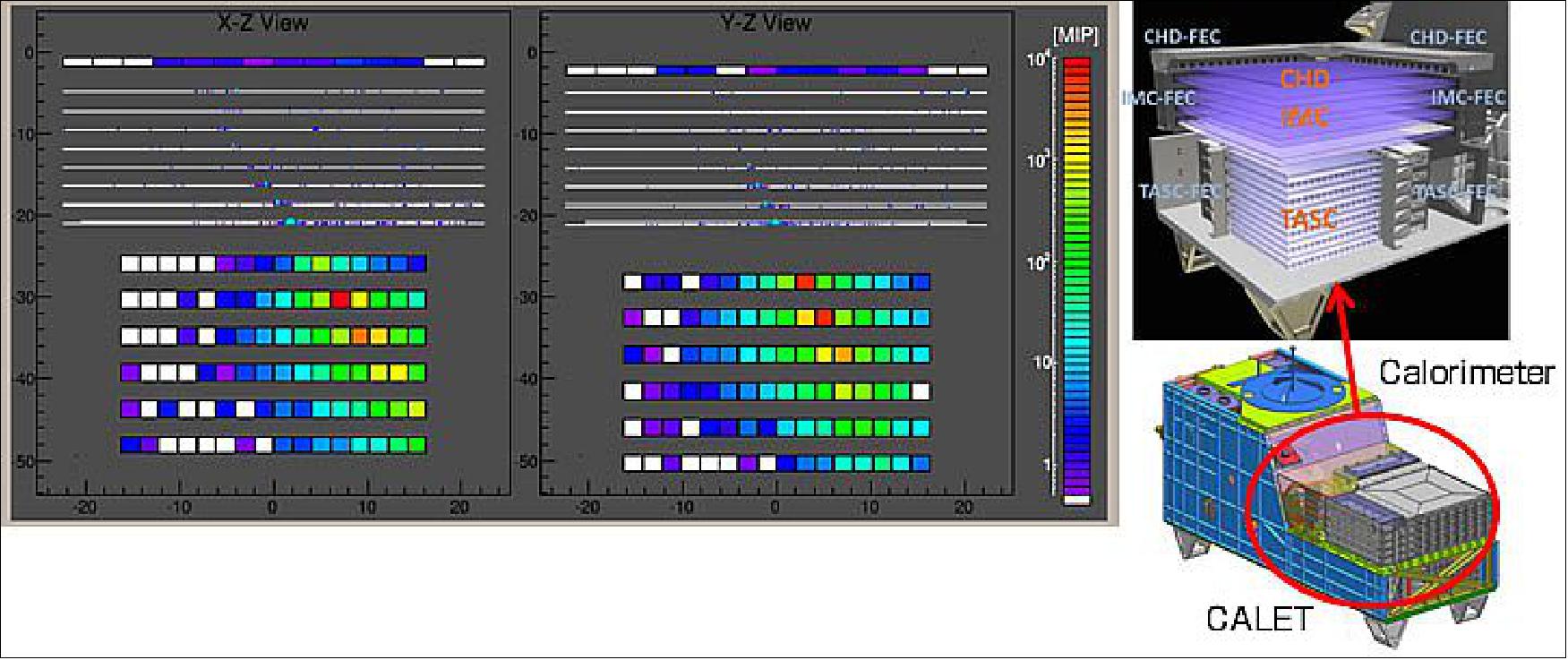
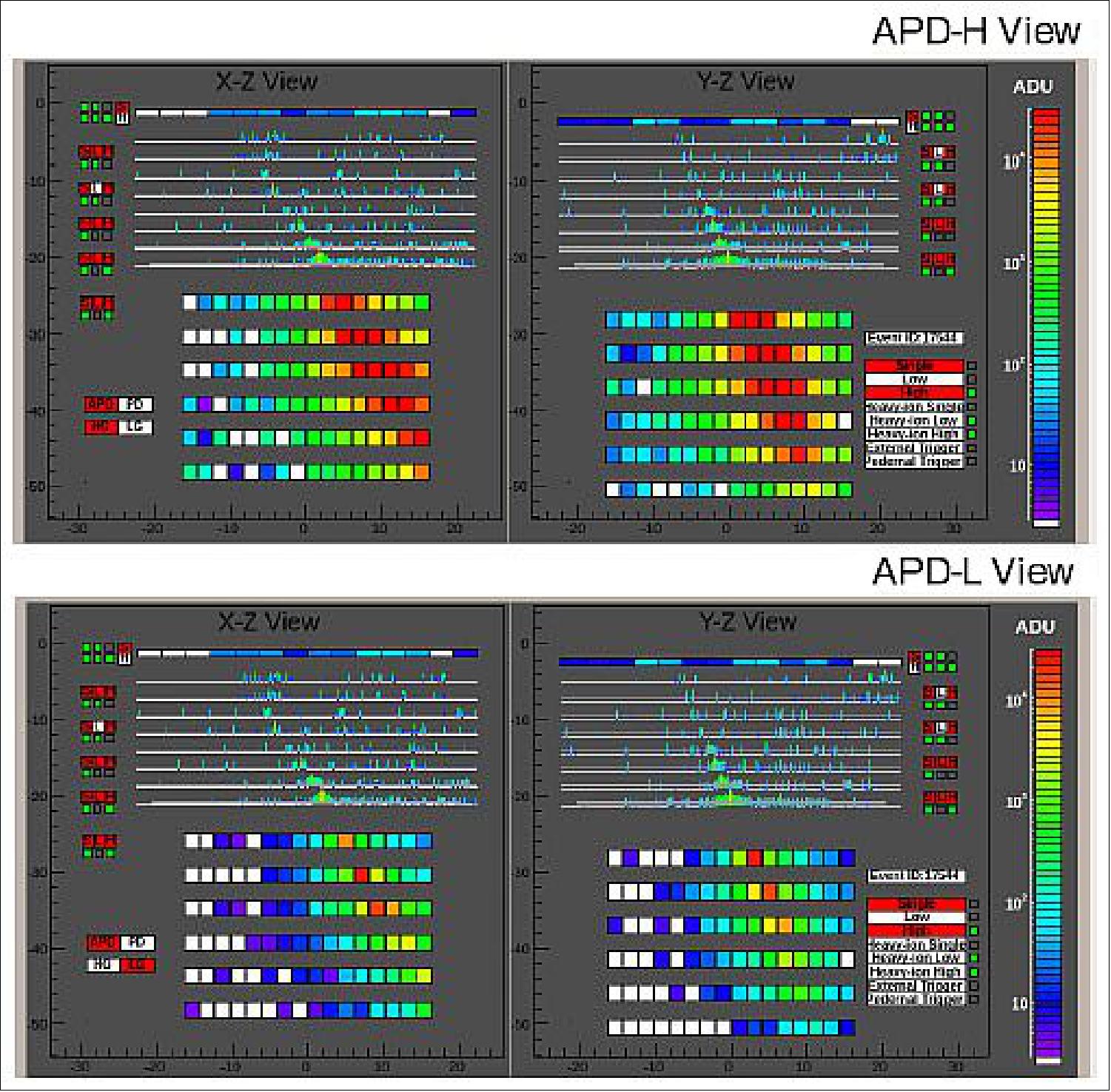

• On August 25, 2015 (2:29 UTC), the CALET instrument was transferred by the Kibo’s robotic arm, namely JEMRMS (JEM Remote Manipulator System) and installed to the Kibo’s Exposed Facility (EF). 23) 24)
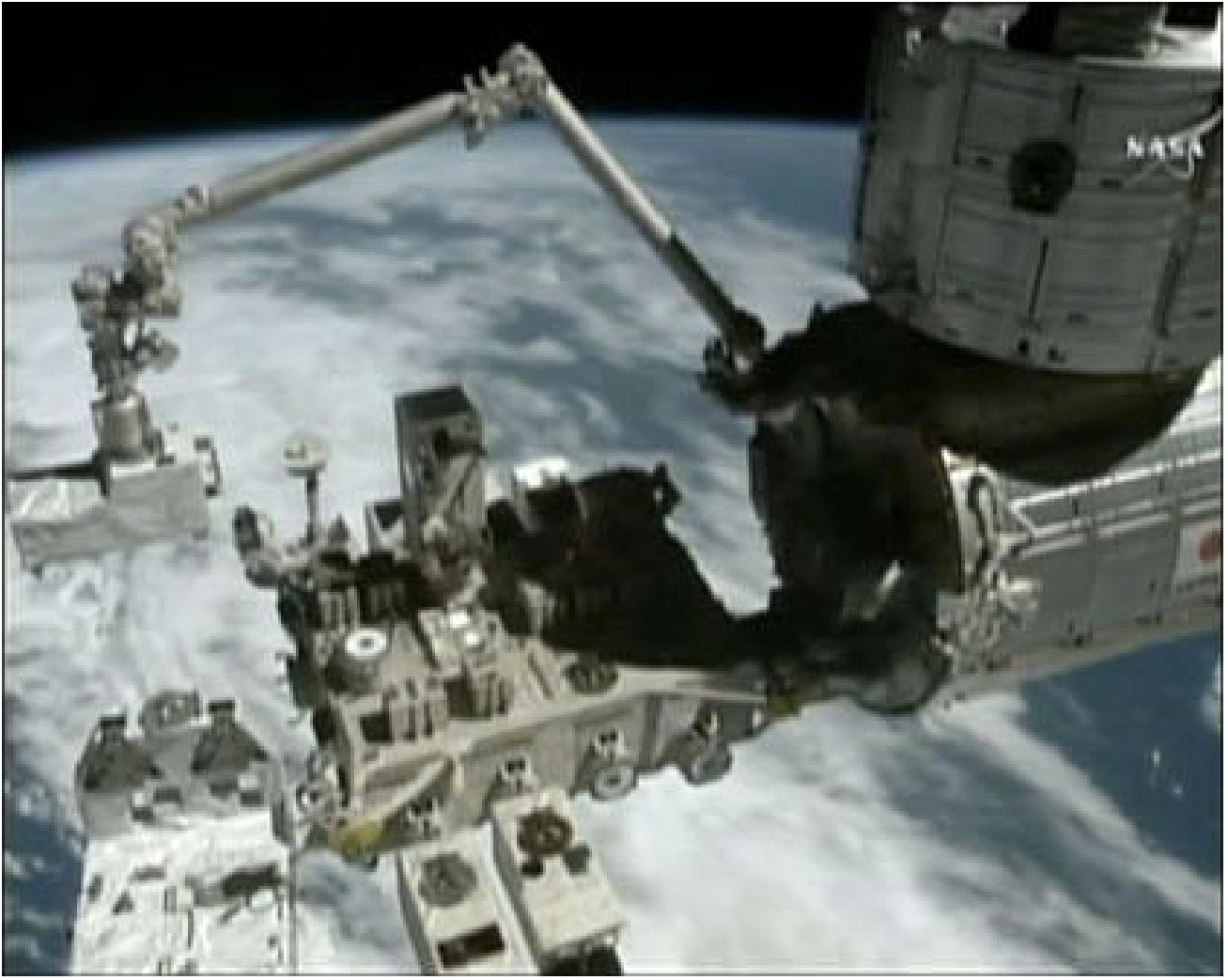
• Japan's HTV-5 cargo freighter completed a five-day flight to the International Space Station on August 24, 2015, making a glacial laser-guided approach to the complex with a 4,300 kg package of food, spare parts and experiments. 25)
- Japanese astronaut Kimiya Yui took control of the space station’s Canadarm2 and latched on to the free-floating HTV-5 supply ship at 10:28 GMT as the complex soared some 400 km over the coast of Brazil.
- A few hours later, the robot arm positioned the 10 m long HTV -5 cargo craft on the Earth-facing port of the space station’s Harmony module, where 16 bolts drove closed to firmly attach the visiting spaceship to the massive orbiting research lab.

Ground Segment
As shown in the left-hand panel of Figure 16, the data obtained from CALET onboard the ISS is transferred, through various satellite and ground links, to JAXA. The JAXA Ground Support Equipment (JAXA-GSE) at JAXA and the Waseda CALET Operations Center (WCOC) at Waseda University were established in order to operate and monitor the CALET onboard the ISS. The raw data received by the JAXA-GSE are immediately transferred to the WCOC for real-time instrument monitoring except for the replayed data stored at the ISS during the loss of signal. Scientific raw data (Level 0) are also transferred from JAXA to WCOC on an hourly basis after the data records are time-order corrected and augmented, if necessary, with data replayed from ISS storage. In this context, the primary responsibility of the WCOC is to manage CALET scientific mission operations including (1) real-time monitoring and operations, (2) operations planning, and (3) scientific data processing. As shown in the right-hand panel of Figure 16, there is an interface to a JAXA ground system corresponding to each role of WCOC, and providing uplink and downlink communication with CALET onboard the ISS. 26)
In order to monitor the observation status of CALET in real time, a quick look (QL) system, which consolidates and visualizes cosmic-ray event data and housekeeping data, was developed. Since a large amount of data must be monitored in real-time in a comprehensive manner, it is necessary to summarize the data and to detect malfunctions automatically. The QL system provides such functions. Using simulated CALET telemetry data, the QL systems are developed early on in a simulation of on-orbit operation, enabling the QL system to be used in CALET system tests, and immediately after its installation on the ISS. Currently, in the stable operation phase, using the QL system, the CALET science team monitors the scientific status and the data transmission on a 24-hour seven-day basis in WCOC.

Data Flow and Data Analysis Framework: The scientific raw data (called CALET Level-0 data) are generated at JAXA and are transferred to the WCOC. The Level-0 data is, in essence, the raw CALET data stream with time ordered data packets collected from near real-time transmission or from replay of data stored on the ISS. At the WCOC, the Level-0 data is converted into Level-1 data, and it is the Level-1 that is distributed to the international collaboration as the base data for the CALET scientific data analysis. Quick analyses based on both Level-0 and Level-1 data are performed and their results are used as feedback for better operations planning and real-time monitoring. Level-1 data include all event, housekeeping, rate, and ancillary data records with timestamps corrected to UTC. The housekeeping temperatures, voltages, and currents are converted to physical units.
The analysis scheme of CALET is shown in Figure 17. Various detector calibrations are performed using the Level-1 data and these calibrations are incorporated into the Level-2 data that is used for physics analysis. For this physics analysis flight data (FD) and Monte Carlo simulation data (MC) are both in Level-2 format and are treated equivalently during analysis. In order to produce the Level-2 data set, the energy deposits of all of the channels are first calculated by applying detector calibrations to the FD and by smearing MC using the measured detector responses. In the process of Level-2 data production, the energy deposit array for both FD and MC is fed into track reconstruction and energy reconstruction. The various variables for event selection are calculated for both FD and MC. The TObjectArray in the ROOT analysis framework provides a flexible format in which it is possible to record the results of multiple algorithms in the Level-2 data, allowing easy comparisons between different algorithms. By taking advantage of such Level-2 data features, an efficient and detailed study of systematic uncertainty becomes feasible.
The calculation nodes at WCOC have over 800 cores working at present, processing the high-level flight data and creating MC data. Spectral data and subsets of data for individual science targets are called Level-3 (or higher) data. Data analysis using each data set will be carried out independently in each institute, and the official dataset to be used for publication is processed at WCOC.
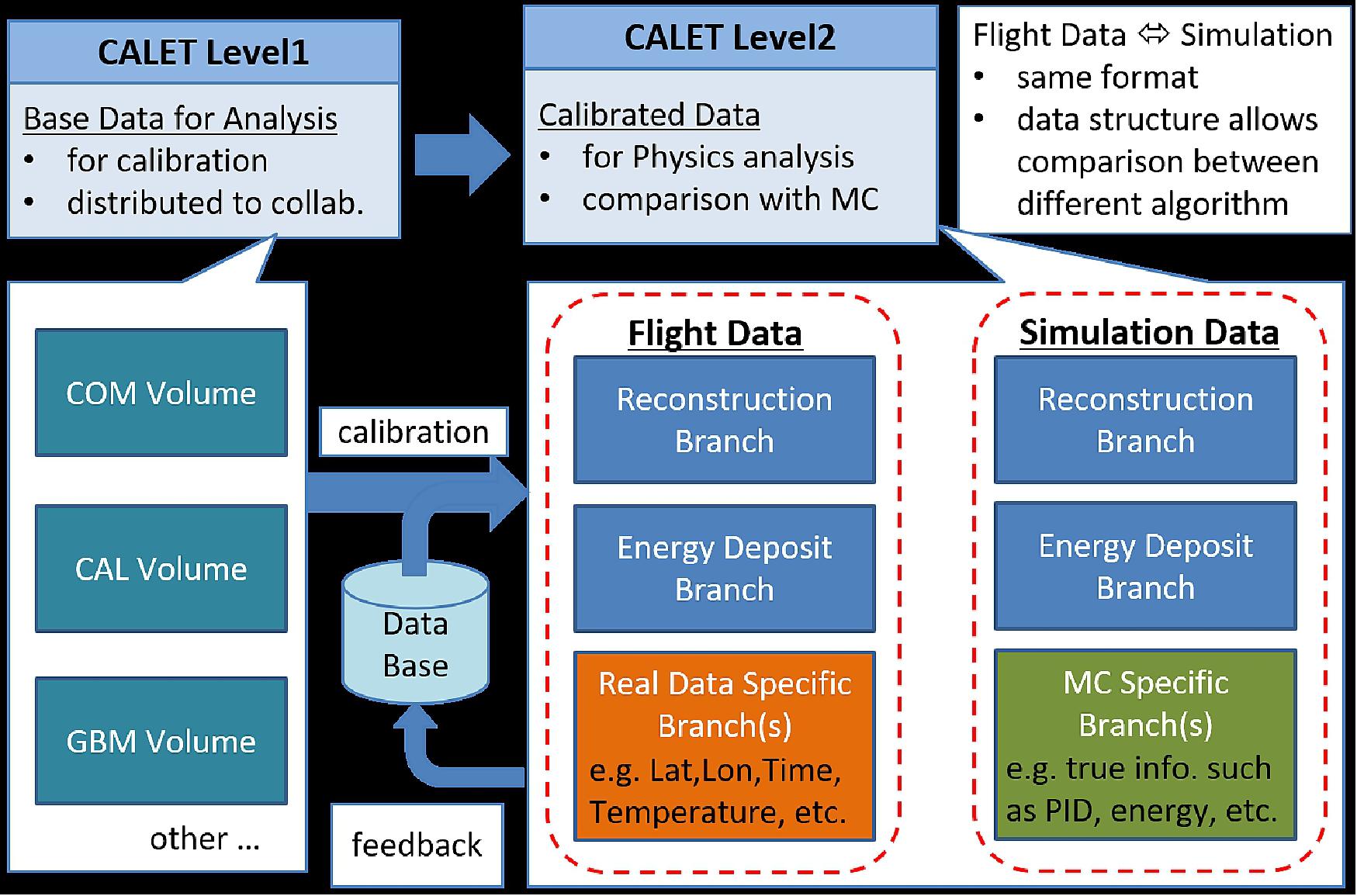
On-Orbit Operations
Observation Planning: The CALET observation mode on orbit is controlled by a regular schedule of command sequences. A calibration data trigger mode that involves, for example, recording pedestal and penetrating particle events, a low-energy electron trigger mode operating at high geomagnetic latitude, and other dedicated trigger modes are scheduled around the ISS orbit while maintaining the maximum exposure to high-energy electrons.
The following modes are combined in a schedule command file, and the trigger rate maps of representative observation modes, as well as a CHD (Charge Detector) count rate map, are shown in Figure 18. The LD threshold settings for each observation mode are summarized in Table 1.
• High-energy shower observation (HE): All electrons and high-energy shower phenomena of gamma rays and nuclei are acquired. The high-energy shower observation is always activated because this is the trigger mode for the main objectives of CALET. Because of the high threshold, the SAA (South Atlantic Anomaly) does not have a significant impact on the trigger rate, as shown in the third panel from the top in Figure 18, making it possible to continue observation even in the SAA.
• Low-energy electron observation (LE-e): For electron data in the 1-GeV region, this mode can acquire the low-energy data efficiently when the geomagnetic cutoff is low. This mode is activated for 90 s at the highest geomagnetic latitude in the north and south regions.
• Low-energy gamma-ray observation (LE-γ): Using the geomagnetic cutoff for charged particles, low-energy gamma ray data is acquired efficiently. Low-energy gamma-ray observation is activated in the low-geomagnetic-latitude region when the geomagnetic latitude is below 20º, except for the SAA. Since it is possible to measure trigger rate without actually taking data, LE-γ trigger rate for the whole orbit is shown in the second panel in Figure 18.
• MIP calibration data acquisition (S-p, S-He): In order to check the equipment gain and stability, we collect non-interacting proton/helium events selectively. MIP calibration data acquisition is normally activated during two consecutive orbits (three hours) per day in order to collect enough statistics to monitor the gain and detector stability.
• Ultra-heavy nuclei observation (UH): A dedicated trigger mode to acquire ultra-heavy nuclei penetrating the CHD and the upper four layers of the IMC is implemented. While the main target of the trigger mode is nuclei of Z>26, the trigger threshold is loose enough to trigger Z≥12 nuclei. The ultra-heavy observation is almost always active because of the low trigger rate.
• Pedestal data acquisition: Pedestal data are periodically acquired at a rate of 100 events every 23 minutes.
Since the UH trigger setting requires implementation as the LE trigger, LE-e and LE-γ observations use Single trigger in the actual observation. As a result, it is not possible to combine LE-e, LE-γ, S-p and S-He observations at the same time.
The command file also includes CGBM control commands to protect the detector from high radiation at high geomagnetic latitude and in the SAA. The execution time of the commands in the file take into account the ISS position and the Acquisition and Loss of Signal (AOS/LOS). The command schedule is created making use of recently observed data and is renewed every day semi-automatically in WCOC.
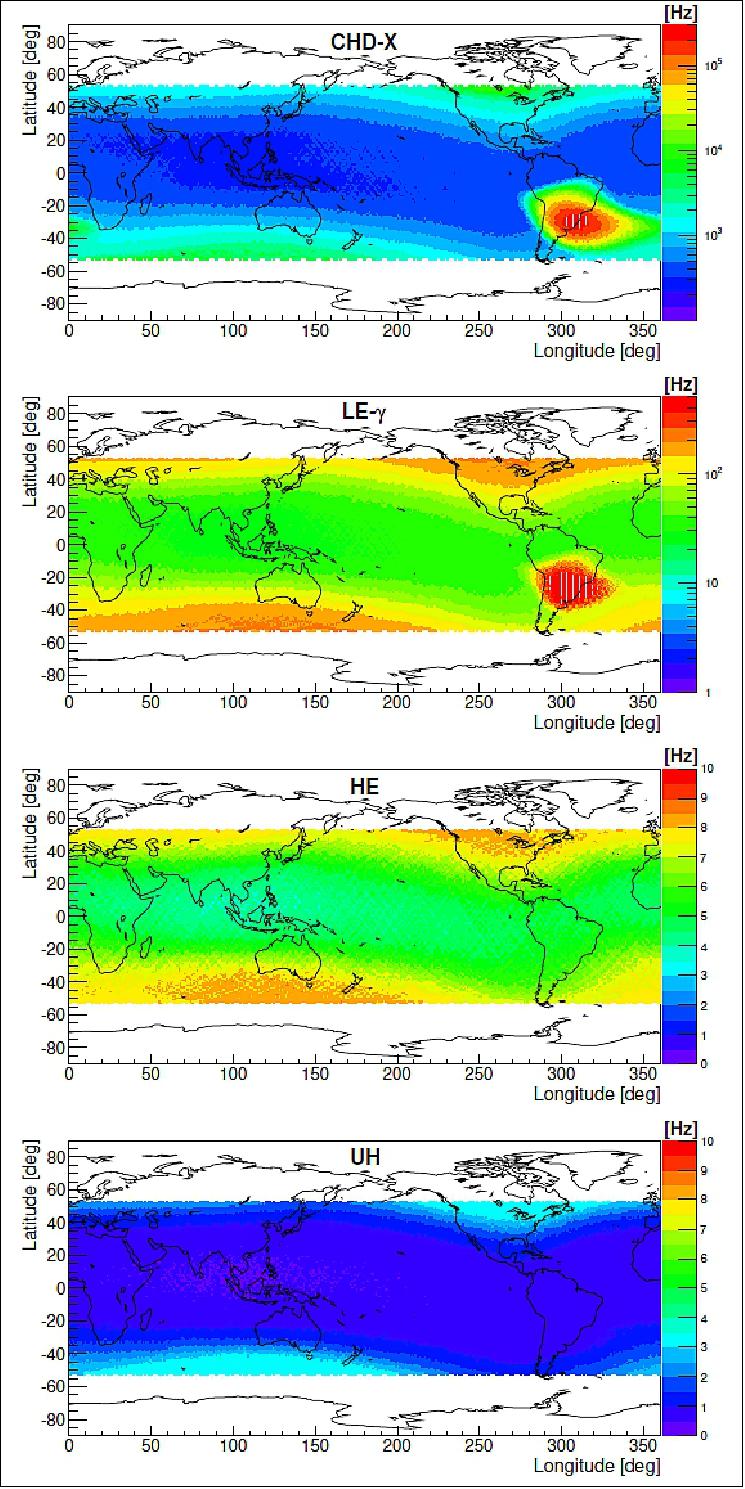
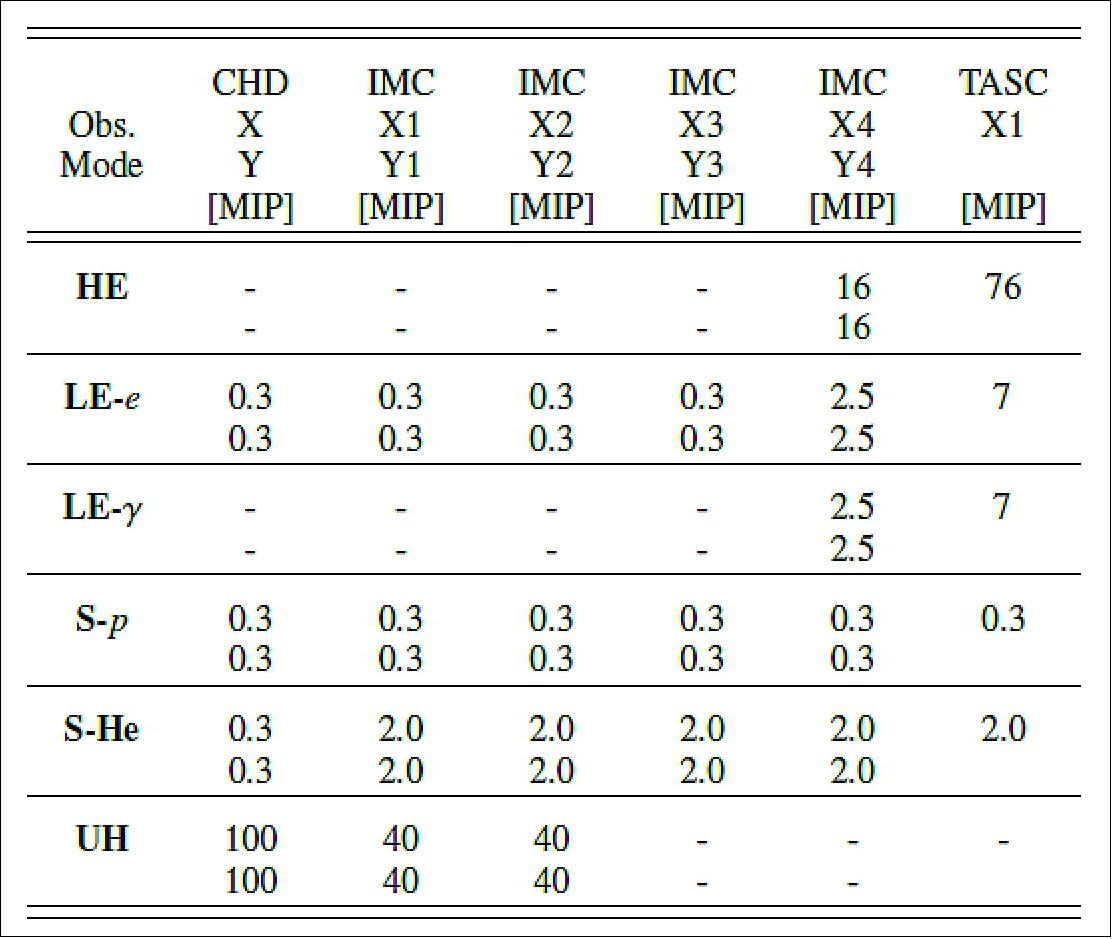
Table 1: Examples of CALET trigger modes. For clarity, the LD thresholds, which are set as 8-bit digitized values, are shown in units of MIP in the table. In the table, “-” indicates that the corresponding LD signal is not required for the trigger.
Statistics of Accumulated Data: From the start of scientific observation, the accumulated number of events through the end of August 2017 is 7.92 x108. Figure 19 shows the TASC (Total AbSorption Calorimeter) energy deposit spectrum for the same period using all of the triggered events. The first bump is due to low-energy triggered events, while the second bump is caused by high-energy triggered events and the tail at high energy reflects the power-law nature of the cosmic-ray spectrum. The spectrum spans more than six orders of magnitude in energy with highest energy past a PeV, and the lowest energy below 1 GeV. This clearly demonstrates the CALET capability to observe cosmic rays over a very wide dynamic range.

Figure 20 shows for the HE-trigger the accumulated live time and number of events. Since October, 2015, the observation time has increased smoothly without serious trouble. Transmission of data from JAXA-GSE to WCOC and processing of the data for scientific analysis at WCOC have also proceeded smoothly. Furthermore, in order to monitor the daily performance of the CALET instrument, data quality check (DQC) plots are defined and processed every day. They are stored at WCOC and can be accessed through a website by the CALET science team members who take the shift at WCOC.
While the UH trigger is almost always active because of the low impact on the HE trigger, the live times of LE triggers are limited. As of the end of August, 2017, the total live time for the LE gamma-ray trigger is 8.42 x 106 s, whereas that for the LE electron trigger is 7.74 x105 s. The rigidity cutoff distribution for the LE electron trigger is shown in the left-hand panel of Figure 21. Since the LE-e observation is performed in the high-latitude region, we have a significant fraction of live time in the rigidity cutoff <1 GV. This makes it possible to measure the temporal variation of the 1-GeV electron flux. The right-hand panel of Figure 21 shows the effective exposure of the LE gamma-ray trigger at 3 GeV in units of cm2s. Since the LE-γ observation is limited to low geomagnetic latitudes, exposure is not uniform in galactic coordinates. Note that the exposure for the HE trigger is much more uniform (not shown) because the observation mode is always active.
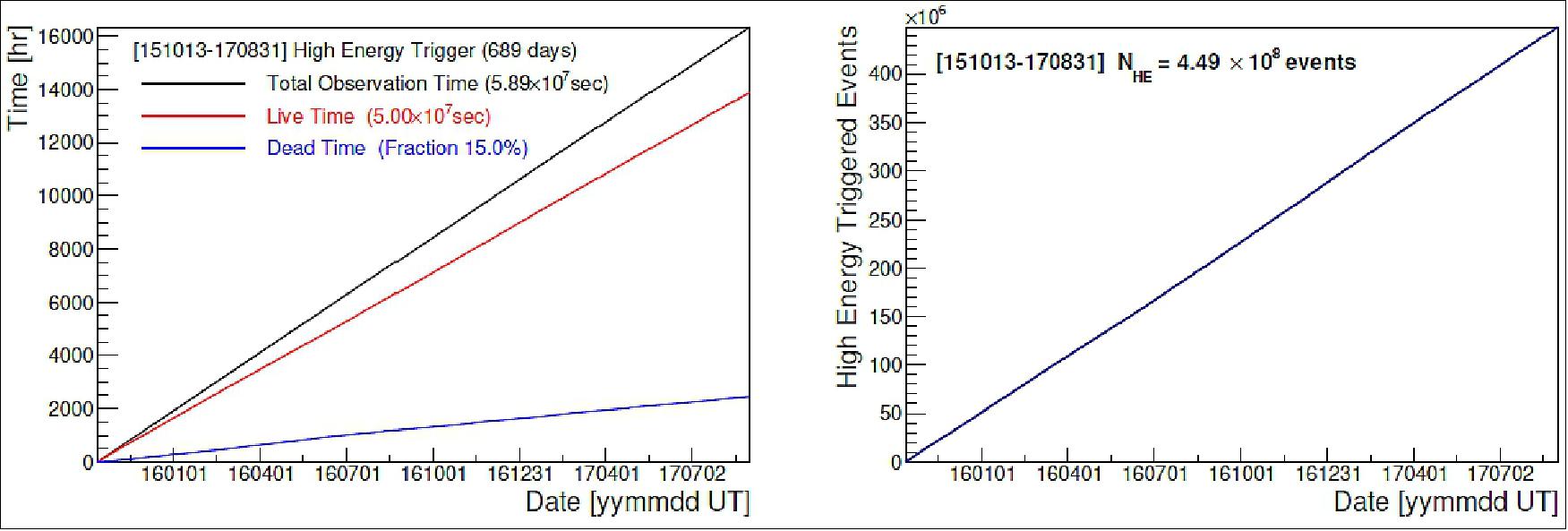

In summary, CALET has been delivering science data with stable instrument performance since October, 2015. As of August 31, 2017, the total observation time is 689 days with a live time fraction close to 84%. Nearly 450 million events have been collected with the high-energy (E >10 GeV) trigger. In addition, a calibration data trigger mode, such as recording pedestal and penetrating particle events, a low-energy electron (gamma-ray) trigger mode operating at high (low) geomagnetic latitude, and other dedicated trigger modes are scheduled around the ISS orbit while maintaining the maximum exposure to high-energy electrons, gamma-rays, and nuclei. The quality of the on-orbit data has been excellent and it is expected that a five-year CALET observation period will provide a wealth of new and interesting results.
References
1) “CALorimetric Electron Telescope (CALET),” JAXA, April 24, 2015, URL: http://iss.jaxa.jp/en/kiboexp/ef/calet/
2) Andrea Dunn, “Stork Set to Make Special Space Station Delivery,” NASA, August 14, 2015, URL: http://www.nasa.gov/mission_pages/station/research/news/htv5_launch
3) ”About the cooperation of JAXA and ASI in the development of CALET,” JAXA, URL: http://iss.jaxa.jp/en/kiboexp/news/130610_calet.html
4) Pier Simone Marrocchesi for the CALET collaboration, ”CALET on the ISS: a high energy astroparticle physics experiment,” XIV International Conference on Topics in Astroparticle and Underground Physics (TAUP 2015) IOP Publishing Journal of Physics: Conference Series 718 (2016) 052023, doi:10.1088/1742-6596/718/5/052023, URL: http://iopscience.iop.org/article/10.1088/1742-6596/718/5/052023/pdf
5) ”CALET CALorimetric Electron Telescope -Instrument,” Waseda University, July 12, 2015, URL: http://calet.jp/en/id49/
6) “Launch Success of H-II Transfer Vehicle Kounotori-5," JAXA Press Release, Aug. 19, 2015, URL: http://global.jaxa.jp/press/2015/08/20150819_h2bf5.html
7) ”New research adds a wrinkle to our understanding of the origins of matter in the Milky Way,” Phys.org news, 18 June 2021, URL: https://phys.org/news/2021-06-wrinkle-milky.html
8) O. Adriani, Y. Akaike, K. Asano, Y. Asaoka, E. Berti,G. Bigongiari,W. R. Binns,M. Bongi,P. Brogi,A. Bruno,J. H. Buckley,N. Cannady,G. Castellini,C. Checchia ,M. L. Cherry,G. Collazuol, K. Ebisawa, H. Fuke,S. Gonzi, T. G. Guzik, T. Hams,K. Hibino, M. Ichimura, K. Ioka, W. Ishizaki, M. H. Israel, K. Kasahara, J. Kataoka, R. Kataoka,Y. Katayose, C. Kato,N. Kawanaka, Y. Kawakubo, K. Kobayashi, K. Kohri, H. S. Krawczynski, J. F. Krizmanic, J. Link, et al. , ”Measurement of the Iron Spectrum in Cosmic Rays from 10 GeV/n to 2.0 TeV/n with the Calorimetric Electron Telescope on the International Space Station,” Physical Review Letters. Volume 126, 241101, Published: 14 June 2021, https://doi.org/10.1103/PhysRevLett.126.241101, URL: https://journals.aps.org/prl/pdf/10.1103/PhysRevLett.126.241101
9) ”CALET succeeds in direct measurements of cosmic-ray electron spectrum up to 4.8 TeV,” Waseda University, 16 July 2018, URL: https://www.waseda.jp/top/en-news/60343
10) O. Adriani, Y. Akaike, K. Asano, Y. Asaoka, M. G. Bagliesi, E. Berti, G. Bigongiari, W. R. Binns, S. Bonechi, M. Bongi, P. Brogi, J. H. Buckley, N. Cannady, G. Castellini, C. Checchia, M. L. Cherry, G. Collazuol, V. Di Felice, K. Ebisawa, H. Fuke, T. G. Guzik, T. Hams, M. Hareyama, N. Hasebe, K. Hibino, M. Ichimura, K. Ioka, W. Ishizaki, M. H. Israel, K. Kasahara, J. Kataoka, R. Kataoka, Y. Katayose, C. Kato, N. Kawanaka, Y. Kawakubo, K. Kohri, H. S. Krawczynski, J. F. Krizmanic, T. Lomtadze, P. Maestro, P. S. Marrocchesi, A. M. Messineo, J. W. Mitchell, S. Miyake, A. A. Moiseev, K. Mori, M. Mori, N. Mori, H. M. Motz, K. Munakata, H. Murakami, S. Nakahira, J. Nishimura, G. A. de Nolfo, S. Okuno, J. F. Ormes, S. Ozawa, L. Pacini, F. Palma, P. Papini, A. V. Penacchioni, B. F. Rauch, S. B. Ricciarini, K. Sakai, T. Sakamoto, M. Sasaki, Y. Shimizu, A. Shiomi, R. Sparvoli, P. Spillantini, F. Stolzi, J. E. Suh, A. Sulaj, I. Takahashi, M. Takayanagi, M. Takita, T. Tamura, N. Tateyama, T. Terasawa, H. Tomida, S. Torii, Y. Tsunesada, Y. Uchihori, S. Ueno, E. Vannuccini, J. P. Wefel, K. Yamaoka, S. Yanagita, A. Yoshida, K. Yoshida, ”Extended Measurement of the Cosmic-Ray Electron and Positron Spectrum from 11 GeV to 4.8 TeV with the Calorimetric Electron Telescope on the International Space Station,”. Physical Review Letters, 25 June 2018, Vol. 120 (26), DOI: 10.1103/PhysRevLett.120.261102, URL of abstract: https://journals.aps.org
/prl/abstract/10.1103/PhysRevLett.120.261102
11) ”First cosmic-ray results from CALET on the ISS,” CERN Courier, 10 Nov. 2017, URL: http://cerncourier.com/cws/article/cern/70347
12) ”CALET makes first direct measurements of high energy electrons in space,” Space Daily, 8 Nov. 2017, URL: http://www.spacedaily.com/reports/
CALET_makes_first_direct_measurements_of_high_energy_electrons_in_space_999.html
13) O. Adriani, Y. Akaike, K. Asano, Y. Asaoka, M. G. Bagliesi, G. Bigongiari, W. R. Binns, S. Bonechi, M. Bongi, P. Brogi, J. H. Buckley, N. Cannady, G. Castellini, C. Checchia, M. L. Cherry, G. Collazuol, V. Di Felice, K. Ebisawa, H. Fuke, T. G. Guzik, T. Hams, M. Hareyama, N. Hasebe, K. Hibino, M. Ichimura, K. Ioka, W. Ishizaki, M. H. Israel, A. Javaid, K. Kasahara, J. Kataoka, R. Kataoka, Y. Katayose, C. Kato, N. Kawanaka, Y. Kawakubo, H.S. Krawczynski, J. F. Krizmanic, S. Kuramata, T. Lomtadze, P. Maestro, P. S. Marrocchesi, A. M. Messineo, J. W. Mitchell, S. Miyake, K. Mizutani, A. A. Moiseev, K. Mori, M. Mori, N. Mori, H. M. Motz, K. Munakata, H. Murakami, S. Nakahira, J. Nishimura, G. A. de Nolfo, S. Okuno, J. F. Ormes, S. Ozawa, L. Pacini, F. Palma, P. Papini, A. V. Penacchioni, B. F. Rauch, S. B. Ricciarini, K. Sakai, T. Sakamoto, M. Sasaki, Y. Shimizu, A. Shiomi, R. Sparvoli, P. Spillantini, F. Stolzi, I. Takahashi, M. Takayanagi, M. Takita, T. Tamura, N. Tateyama, T. Terasawa, H. Tomida, S. Torii, Y. Tsunesada, Y. Uchihori, S. Ueno, E. Vannuccini, J. P. Wefel, K. Yamaoka, S. Yanagita, A. Yoshida, K. Yoshida, T. Yuda, ”Energy Spectrum of Cosmic-Ray Electron and Positron from 10 GeV to 3 TeV Observed with the Calorimetric Electron Telescope on the International Space Station,” Physical Review Letters, Vol. 119, 181101, Issue 18-3, published on 1 Nov. 2017, doi: https://doi.org/10.1103/PhysRevLett.119.181101
14) Shoji Torii for the CALET collaboration, ”The CALorimetric Electron Telescope(CALET) : In-flight performance and preliminary results,” TeVPA2016 (TeV Particle Astrophysics) Conference @CERN, September 12-16,2016, URL: http://calet.jp/wp-content/uploads/2016/10/TeVPA2016-Torii.pdf
15) Note: Geomagnetic latitude: The bearing of geomagnetic latitude is determined based on the magnetic poles of Earth, not on such axis as the geographic latitude.
16) ”CALET has succeeded in observing electron precipitation,” National Institute of Polar Research (NIPR), Waseda University, JAXA, July 6, 2016, URL: http://iss.jaxa.jp/en/kiboexp/news/20160706_calet.html
17) Ryuho Kataoka, Yoichi Asaoka, Shoji Torii, Toshio Terasawa, Shunzuke Ozawa, Tadahisa Tamura, Yuki Shimizu, Yosui Akaike, Masaki Mori, ”Relativistic electron precipitation at International Space Station: Space weather monitoring by Calorimetric Electron Telescope,”Geophysical Research Letters, Volume 43, Issue 9, 16 May 2016, pp: 4119–4125, DOI: 10.1002/2016GL068930
18) Koki Oikawa, ”Maximizing Benefits through ISS/Kibo,” The 53rd Session of Scientific and Technical Subcommittee of the Committee on the Peaceful Uses of Outer Space, Vienna, Austria, Feb. 15-26, 2016, URL: http://www.unoosa.org/documents/pdf/copuos/stsc/2016/tech-31E.pdf
19) Holger Motz, Yoichi Asaoka, Shoji Torii, Saptashwa Bhattacharyya , Yosui Akaike, ”Ability of CALET to Identify or Constrain Dark Matter Annihilation and Decay in the Galactic Halo,” The 16th Space Science Symposium, URL: http://calet.jp/en/wp-content/uploads/sites/2/2016/01/ISAS-poster2016.pdf
20) CALorimetric Electron Telescope (CALET) aboard the ISS "Kibo" Started the First Direct Electron Observation in Tera Electron Volt Region,” JAXA Press Release, October 22, 2015, URL: http://global.jaxa.jp/press/2015/10/20151022_calet.html#pict01
21) CALET brochure, JAXA, URL: http://iss.jaxa.jp/en/kiboexp/ef/calet/pdf/calet_6p_20140314.pdf
22) ”Exposed Facility (EF) Payloads,” JAXA, 2016, URL: http://iss.jaxa.jp/en/kiboexp/ef/
23) ”CALET installation completed,” JAXA, Aug. 26, 2015, URL: http://iss.jaxa.jp
/en/htv/mission/htv-5/news/150826_calet_installed.html
24) Shoji Torii for the CALET collaboration, ”The CALorimetric Electron Telescope (CALET): High Energy Astroparticle Physics Observatory on the International Space Station,” The 34th International Cosmic Ray Conference, 30 July- 6 August, 2015, The Hague, The Netherlands, URL: http://pos.sissa.it/archive/conferences/236/581/ICRC2015_581.pdf
25) Stephen Clark, ”Japanese HTV supply carrier reaches space station,” Spaceflight Now, August 24, 2015, URL: http://spaceflightnow.com/2015/08/24/japanese-htv-supply-carrier-reaches-space-station/
26) Y. Asaoka, S. Ozawa, S. Torii, O. Adriani, Y. Akaike, K. Asano, M.G. Bagliesi, G. Bigongiari, W. R. Binns, S. Bonechi, M. Bongi, P. Brogi, J. H. Buckley, N. Cannady, G. Castellini, C. Checchia, M. L. Cherry, G. Collazuol, V. Di Felice, K. Ebisawa, H. Fuke, T. G. Guzik, T. Hams, M. Hareyama, N. Hasebe, K. Hibino, M. Ichimura, K. Ioka, W. Ishizaki, M. H. Israel, A. Javaid, K. Kasahara, J. Kataoka, R. Kataoka, Y. Katayose, C. Kato, N. Kawanaka, Y. Kawakubo, K. Kohri, H. S. Krawczynski, J. F. Krizmanic, S. Kuramata, T. Lomtadze, P. Maestro, P. S. Marrocchesi, A. M. Messineo, J. W. Mitchell, S. Miyake, K. Mizutani, A. A. Moiseev, K. Mori, M. Mori, N. Mori, H. M. Motz, K. Munakata, H. Murakami, S. Nakahira, J. Nishimura, G. A. de Nolfo, S. Okuno, J. F. Ormes, L. Pacini, F. Palma, P. Papini, A. V. Penacchioni, B. F. Rauch, S. B. Ricciarini, K. Sakai, T. Sakamoto, M. Sasaki, Y. Shimizu, A. Shiomi, R. Sparvoli, P. Spillantini, F. Stolzi, I. Takahashi, M. Takayanagi, M. Takita, T. Tamura, N. Tateyama, T. Terasawa, H. Tomida, Y. Tsunesada, Y. Uchihori, S. Ueno, E. Vannuccini, J. P. Wefel, K. Yamaoka, S. Yanagita, A. Yoshida, K. Yoshida, T. Yuda, ”On-orbit Operations and Offline Data Processing of CALET onboard the ISS,” Astroparticle Physics, Published , 15 March 2018, URL: https://arxiv.org/pdf/1803.05834.pdf
27) Garcia, Mark. “Partners Extend International Space Station for Benefit of Humanity – Space Station.” NASA Blogs, 27 April 2023, https://blogs.nasa.gov/spacestation/2023/04/27/partners-extend-international-space-station-for-benefit-of-humanity/
The information compiled and edited in this article was provided by Herbert J. Kramer from his documentation of: ”Observation of the Earth and Its Environment: Survey of Missions and Sensors” (Springer Verlag) as well as many other sources after the publication of the 4th edition in 2002. - Comments and corrections to this article are always welcome for further updates (eoportal@symbios.space).